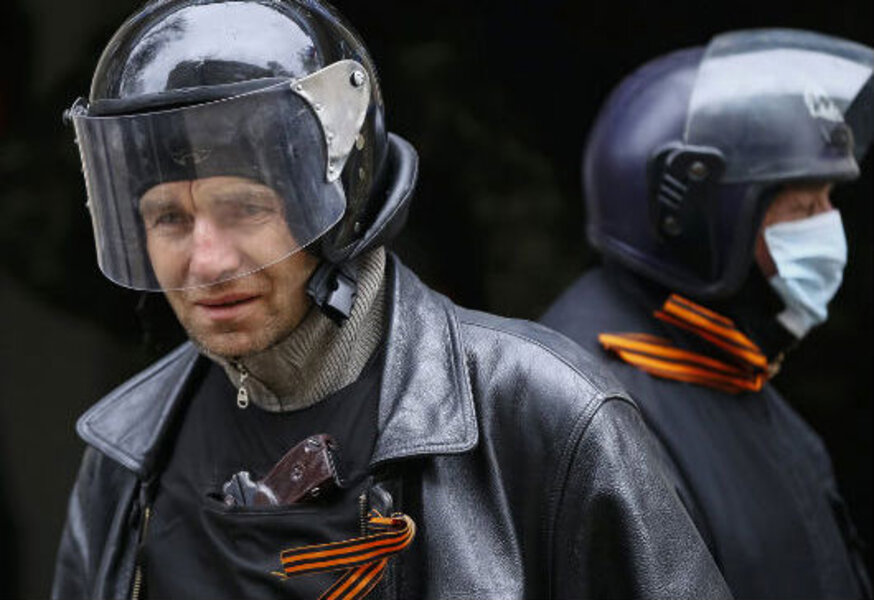An orange-black ribbon holds a clue to eastern Ukraine's chaos
Loading...
As pro-Russia protests spread in eastern Ukraine, a strip of striped orange-and-black fabric has become as ubiquitous as the armed men in unmarked military fatigues.
Its name is the Ribbon of Saint George. Imbued with history, it’s a powerful symbol in the ongoing information battle over Ukraine. For Russians it's a mark of allegiance to the state – both the fearsome, expansionist Russian state of old and its modern successor under President Vladimir Putin.
When pro-Russia rallies took place last December, seeking to rival the Maidan demonstrations in Kiev, very few ribbons were seen. That all changed after the fall of President Viktor Yanukovych and the secessionist fires in Crimea: The ribbon appeared first in flags flying over public rallies in Crimea; then pinned to the suits of Russian Duma deputies as they annexed the peninsula; and now tied to bulletproof vests and weapons of pro-Russian militiamen in eastern Ukraine.
The ribbon traces its roots to the 18th century Russian Empire, when Catherine the Great instituted a new top decoration for battlefield valor: the Cross of Saint George (the same Saint George who slays a dragon on the Russian coat of arms). This tradition continued under successive czarist rulers.
But the orange and black stripes reached new heights during World War II, when they were incorporated into the Soviet Order of Glory in 1943. More than a million people received the award for “feats of bravery, courage, and fearlessness in the battle for the Soviet Motherland” against Nazi Germany in which almost 14 million Russian civilians and soldiers died. (Nearly 9 million died in Ukraine, then a Soviet republic.)
The ribbon made a post-Soviet comeback as part of the Order of Saint George, initiated by the Russian Federation in 1992. The award was presented to Russian military officers and soldiers during the 2008 war with Georgia.
Victory parade
For many Russians and Russian speakers, especially the elderly, the ribbon is a direct link to family members who fought and suffered in World War II. During the annual Victor Day parade on May 9, the Kremlin funds the distribution of hundreds of thousands of ribbons to the public in Russia and abroad, and wearing one is a sacred ritual.
Even for younger generations, the ribbon remains a symbol of historic glory and patriotism in World War II, along with the image of red stars gleaming on Red Army hats – millions of them – as soldiers marched off to the front. The ribbon is a part of Russians' identity, regardless of political affiliation, and to renounce its significance is to spurn your past.
And this fits perfectly into Moscow's explanation of events in eastern Ukraine: a righteous revolt by Russian-speaking citizens against Kiev’s illegitimate new government and its “fascist” followers. For Russians speaker in Donetsk or Slovyansk, it’s easy to feel an affinity with protesters displaying the orange-and-black stripes.
Many Ukrainians have objected to the hijacking of the ribbon of St. George by instigators of separatist protests, calling it a perversion of historic memory. Some are even calling it the “Colorado ribbon,” after the similarly colored Colorado beetle that infests potato fields across Eastern Europe. At least one Maidan activist has made a show of burning three ribbons in the eternal flame in Odessa. All of this is grist to the mill of pro-Russian agitation and popular paranoia.








